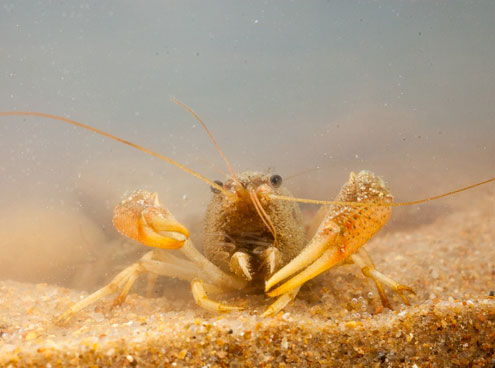With bucket in hand me and my boy headed down to the duck marsh where we hunt. During the winter, the two acre marsh - which was created by my brother out of a flat bottomland hayfield that lies next to a creek - floods with about a foot of water and creates a wetland habitat that attracts ducks on a daily basis. After duck season, he drains the marsh so moist soil grasses and forbs will grow and provide food for next seasonís ducks. When the weather warms and the water drains away, the flat marsh bottom (made from a thick clay gumbo mud for which the blackland prairies are famous) becomes a popular destination for scores of crawdads.
Mud chimneys are everywhere. At each place a chimney stands, a crawdad carefully dug a vertical burrow that fills with water and then capped the opening with the spoils from its labor: chunks of stacked mud.
We find a big chimney and carefully pluck it apart from the mud. In doing so, we expose a wide and nearly symmetrical hole that plunges deep into the marshís basin. Itís so deep, I canít even see a shiny disk of water down in the hole. However, the dig is fresh so we know a crawdad lurks beneath. So with bacon tied to a string harvested from the end of a feed sack, my boy lowers the bait into the hole and waits for a tug.
He doesnít have to wait long.
Crawfish, crayfish, or crawdad?
What the crustacean is called depends mostly on where you are from. In Texas all the species are commonly called crawdads or crawfish. In the eastern United States, however, they are commonly called crayfish.

Whatever you call them, crawdads are a species of freshwater crustaceans that live in water that does not completely freeze. As bottom dwellers, they feed off of live animals, carrion, and plant materials. They are an old species and fossil records document their existence for at least 30 million years.
Worldwide, over 500 species of crawdads are recognized, 350 of which live in North America. While crawfish are found all over the United States, they are found in greater numbers and species diversity in the southeastern United States in the warmer, wetter areas of the south.
Texas is home to at least 43 different species of crawfish - seven of which are listed either as endangered or threatened. The most pressing concern for Texas crawfish is habitat destruction due to development and pollution of waterways.
Most of the stateís species diversity reside in the southeastern portion of the state where the climate is consistently warmer and wetlands are in more abundance. At least two species exist away from wetlands and burrow into the deep soils of the blackland prairies. These species emerge from the burrows to feed and are equipped to ride out times of drought as they dig their burrow deeper and deeper as they follow a shrinking water table.